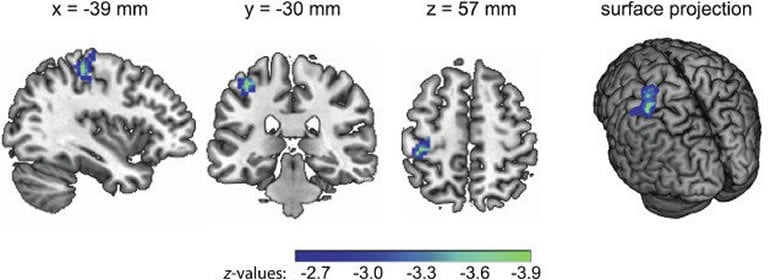Summary: Using transcranial alternating current stimulation, researchers were able to influence the activity of specific brain areas and manipulate the abilities processed by them. Findings suggest tACS could be used to improve, direct, and attenuate the flow of information in the brain.
Source: Max Planck Institute
Stroke, Parkinson’s disease and depression – these medical illnesses have one thing in common: they are caused by changes in brain functions. For a long time, research has therefore been conducted into ways of influencing individual brain functions without surgery in order to compensate for these conditions.
Scientists at the Max Planck Institute for Human Cognitive and Brain Sciences in Leipzig, Germany, have taken a decisive step. They have succeeded in precisely influencing the functioning of a single area of the brain. For a few minutes, they inhibited exactly the area that processes the sense of touch by specifically intervening in its rhythm. As a result, the area that was less networked with other brain regions, its so-called functional connectivity, decreased, and thus also the exchange of information with other brain networks.
This was possible because the researchers had previously determined each participant’s individual brain rhythm that occurs when perceiving touch. With the personal frequency, they were able to modulate the targeted areas of the brain one at a time in a very precise manner using what is known as transcranial alternating current stimulation. “This is an enormous advance,” explains Christopher Gundlach, first author of the underlying study. “In previous studies, connectivity fluctuated extensively when the current was distributed in different areas of the brain. The electrical current randomly sought its own path in the brain and thus affected different brain areas simultaneously in a rather imprecise manner.

In a preliminary study, the neuroscientists had already observed that this form of stimulation not only reduces the exchange of the targeted brain networks with other networks, it also affects the brain’s ability to process information, in this case the sense of touch. When the researchers inhibited the responsible somatosensory network, the perception threshold increased. The study participants only perceived stimuli when they were correspondingly strong. When, on the other hand, they stimulated the region, the threshold value dropped and the study participants already felt very gentle electrical stimuli.
“The deliberate change in brain rhythm lasted only briefly. As soon as the stimulation is switched off, the effect disappears again,” explains study leader Bernhard Sehm. “Nevertheless, the results are an important step towards a targeted therapy for diseases or disorders caused by disturbed brain functions”. Targeted brain stimulation could help to improve, direct and, if necessary, attenuate the flow of information.
About this neuroscience research article
Source:
Max Planck Institute
Contacts:
Verena Müller – Max Planck Institute
Image Source:
The image is credited to NeuroImage.
Original Research: Open access
“Reduction of somatosensory functional connectivity by transcranial alternating current stimulation at endogenous mu-frequency” by Christopher Gundlach, Matthias M Müller, Maike Hoff, Patrick Ragert, Till Nierhaus, Arno Villringer, Bernhard Sehm. NeuroImage.
Abstract
Reduction of somatosensory functional connectivity by transcranial alternating current stimulation at endogenous mu-frequency
Alpha, the most prominent human brain rhythm, might reflect a mechanism of functional inhibition for gating neural processing. This concept has been derived predominantly from local measures of inhibition, while large-scale network mechanisms to guide information flow are largely unknown. Here, we investigated functional connectivity changes on a whole-brain level by concurrent transcranial alternating current stimulation (tACS) and resting-state functional MRI in humans. We specifically focused on somatosensory alpha-band oscillations by adjusting the tACS frequency to each individual´s somatosensory (mu-) alpha peak frequency (mu-tACS). Potential differences of Eigenvector Centrality of primary somatosensory cortex (S1) as well as on a whole brain level between mu-tACS and sham were analyzed. Our results demonstrate that mu-tACS induces a locally-specific decrease in whole-brain functional connectivity of left S1. An additional exploratory analysis revealed that this effect primarily depends on a decrease in functional connectivity between S1 and a network of regions that are crucially involved in somatosensory processing. Furthermore, the decrease in functional centrality was specific to mu-tACS and was not observed when tACS was applied in the gamma-range in an independent study. Our findings provide evidence that modulated somatosensory (mu-) alpha-activity may affect whole-brain network level activity by decoupling primary sensory areas from other hubs involved in sensory processing.






